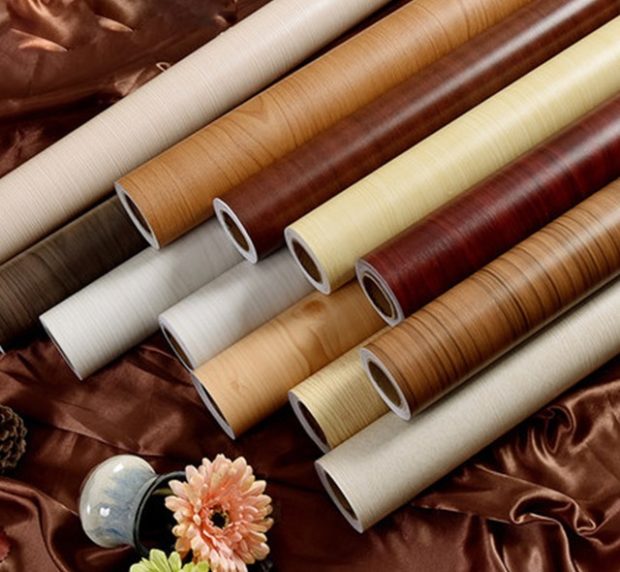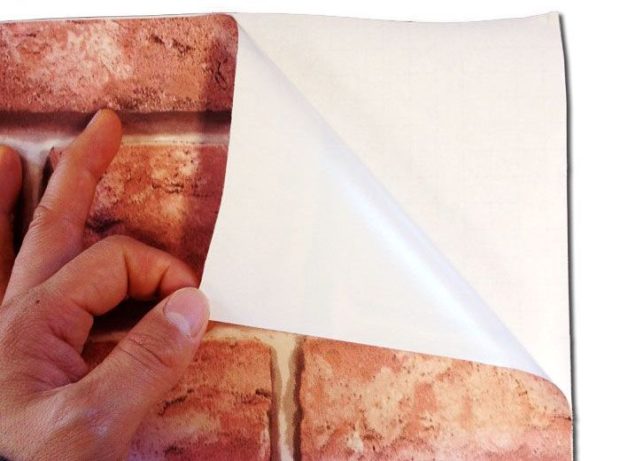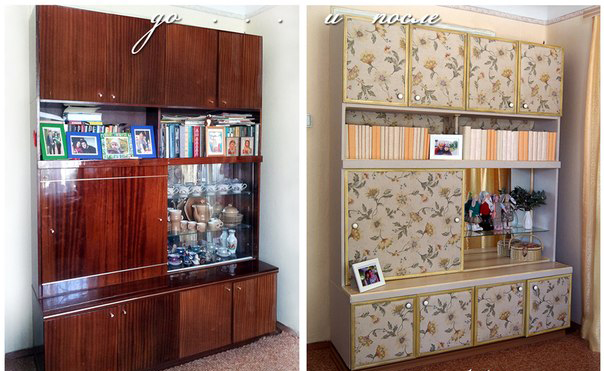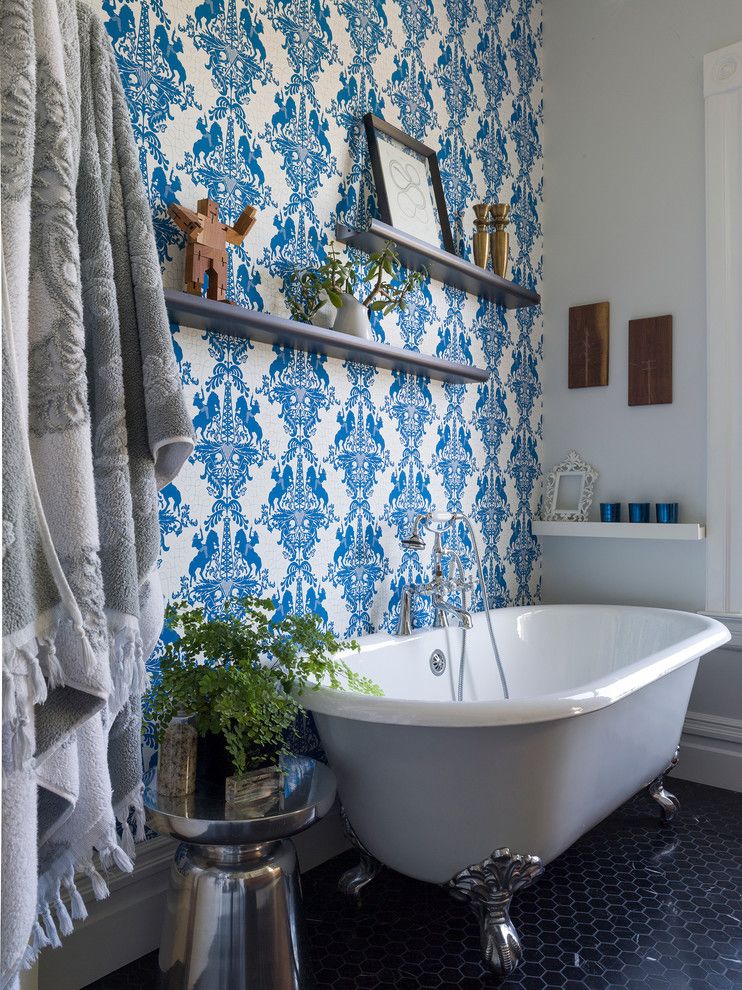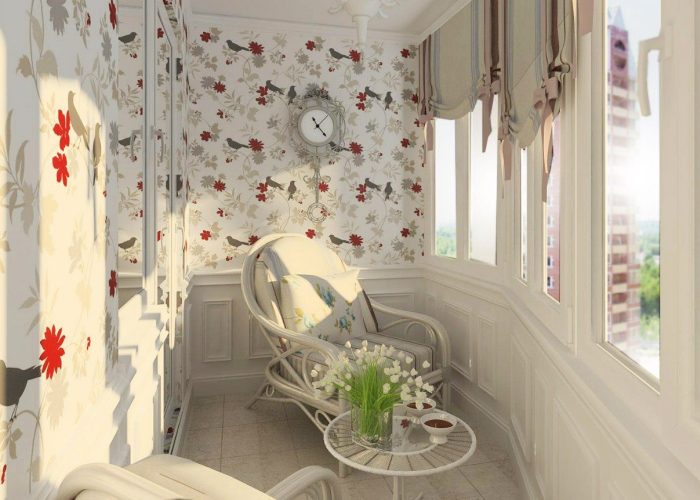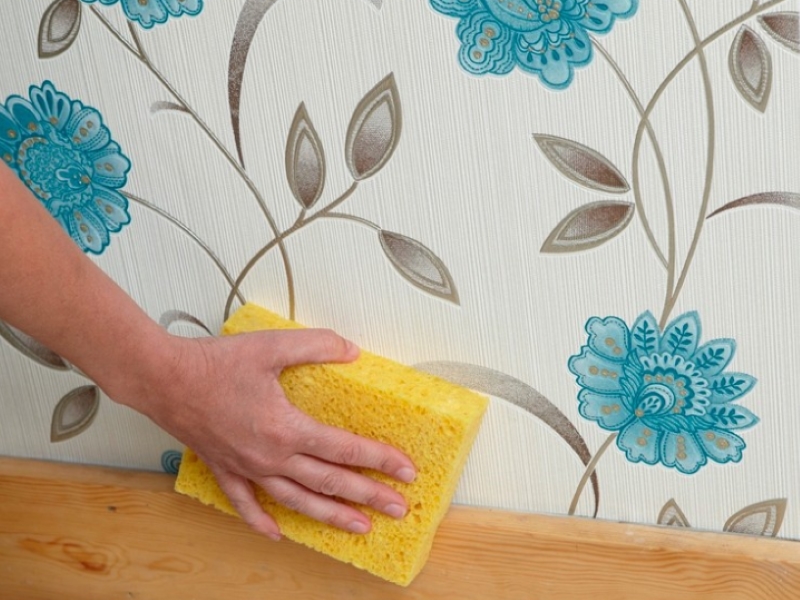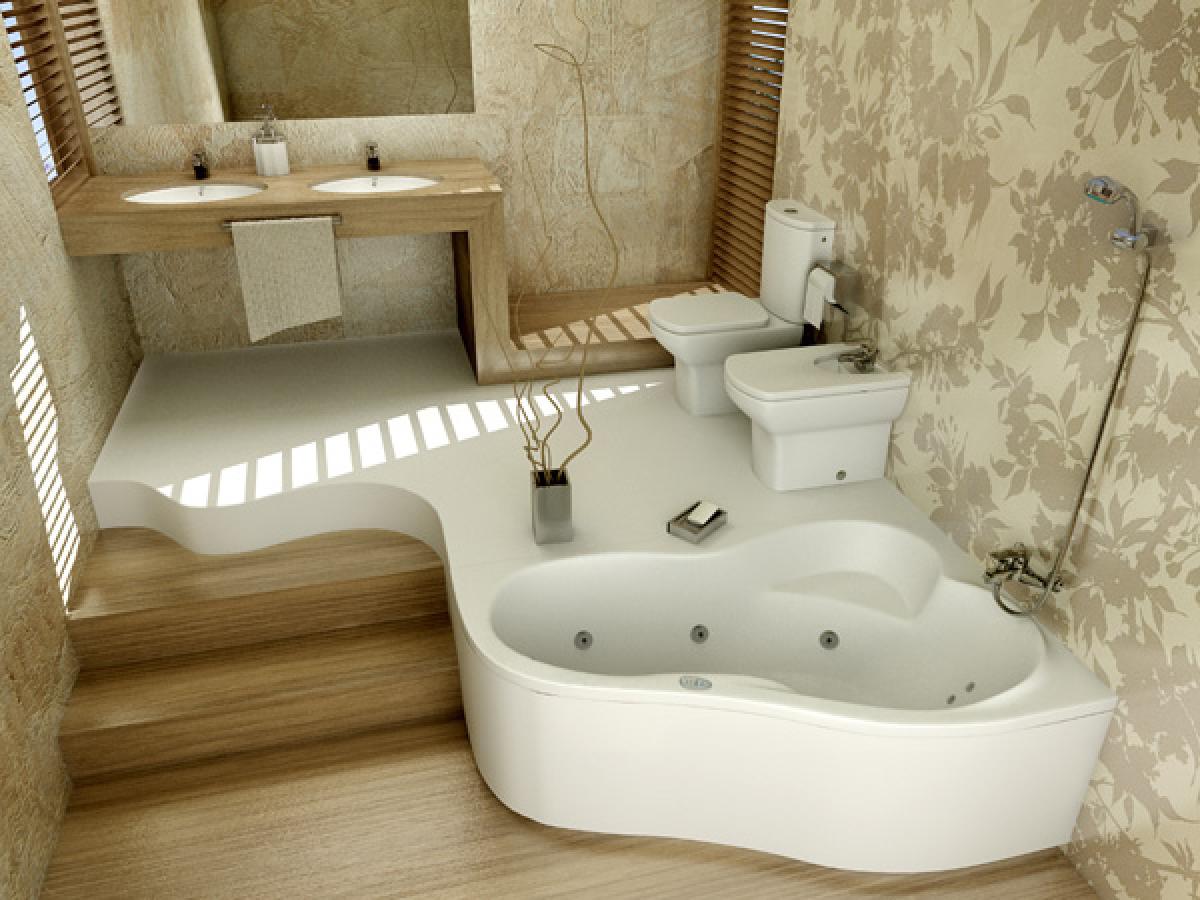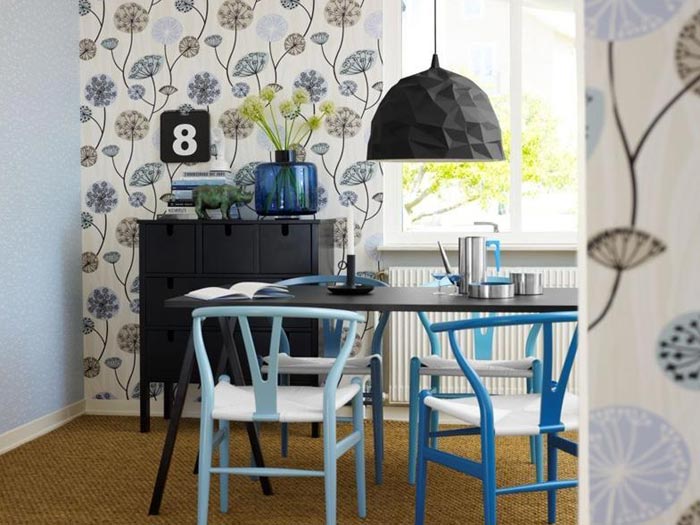Self-adhesive wallpaper for walls: 5 tips for choosing and sticking
One who at least once glued wallpaper, It is recognized that the most difficult stage is the application of glue in accordance with all the rules. Any blemish can affect the final result. To make life easier for millions of people around the world, self-adhesive wallpapers have been invented. They were developed a long time ago, but have recently begun to enjoy wide popularity, and this is due to the expansion of the range and the appearance of a wide variety of colors. Self-adhesive wallpapers are used for decoration of walls, furniture, appliances and doors, and even a novice master can handle the sticking.
No. 1. What are self-adhesive wallpapers?
Wallpaper is the most popular type of wall decoration. It's hard to argue with that. A wide variety brought them popularity. The market offers paper and vinyl, cork and textured, washable and liquid wallpapers, and there is no need to talk about an assortment of colors and patterns. With the advent of photo wallpaper and self-adhesive wallpaper, the variety has become indecently wide at all. Large sellers offer several hundred, and sometimes thousands, options to choose from.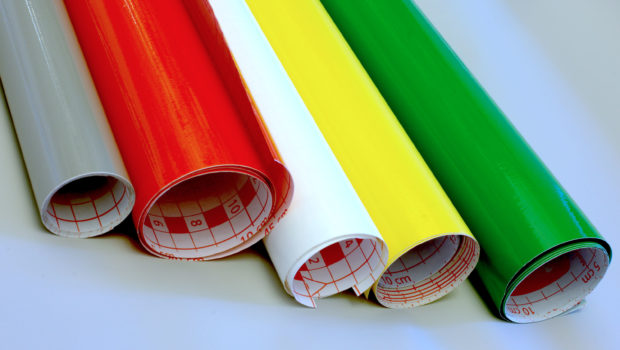
The release of self-adhesive wallpaper is adjusted by many manufacturers. Buying the right option is not difficult. No matter how bizarre the coloring may be, the structure of the material remains unchanged: on the one hand - the decorative part, on the other - the adhesive side that is covered with protective paper. After cutting and immediately before the installation process, the protection is removed. It turns out that there is no need to look for a certain adhesive composition and prepare it. You also don’t have to buy brushes, plumb bells and other tools, and keep the windows closed so that the draft does not interfere with the gluing process, you also do not need to.
Self-adhesive wallpapers are sold in rolls of approximately 14 m, 40-90 cm wide. They are used for wall decoration, restoration of furniture and decor of other interior items.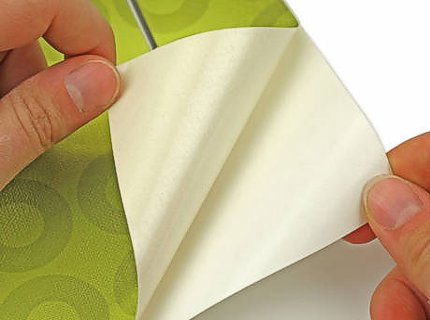
No. 2. Advantages and disadvantages
The main advantage of the material is simple and quick installation process. Self-adhesive wallpaper and other benefits:
- moisture resistancetherefore material is suitable for wall decoration in bathrooms and kitchens. However, experts do not recommend lining them with “cold” walls, since condensation may begin to accumulate under the film, which will gradually lead to the formation of mold and fungus;
- resistance to ultraviolet rays, long preservation of the original colors;
- resistance to high (up to +800C) and low temperatures (-400FROM);
- strength and durabilitywear resistance;
- harmlessness for good health. Both during installation and during operation, toxic fumes are absent;
- a huge variety of drawings and textures. Can find wood wallpaper and stone, with a floral print, an intricate fantasy pattern, with a matte or glossy surface. There are even photo prints, better known as self-adhesive photo wallpaper - In general, there is plenty to choose from;
- universality, wide scope. Self-adhesive (so-called self-adhesive wallpaper) is used for wall decoration, a quick change of scenery, restoration or modernization of furniture, for pasting a door leaf and other purposes;
- low cost material only favors experimentation.
Consas such, no. One has only to keep in mind that the material is quite thin and will give out all surface irregularitiesso that the walls should be even or with minimal defects - there will be no concessions. Self-adhesive wallpaper made by based on polyvinyl chloride, although they are distinguished by the best operational qualities, but they have a significant minus - they do not let air in. If part of the wall is lined with such material, then nothing bad will happen, but if all the walls, then it will be necessary to take care of reliable ventilation.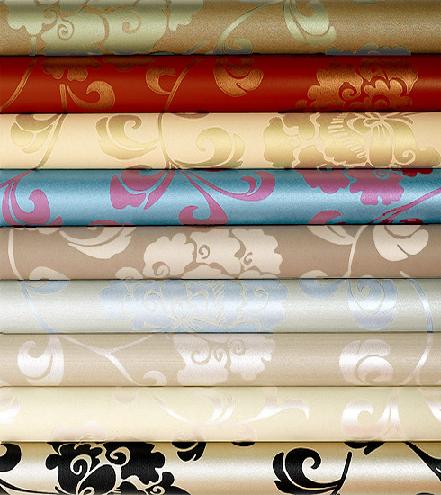
No. 3. The main types of self-adhesive wallpaper
Varieties do not occupy this material, but we will try to classify the entire range of products presented.
So, according to the material of manufacture, all wallpapers can be divided into the following types:
- polyvinyl chloride (PVC). This is the most popular wallpaper, which is popularly called self-adhesive. It is based, as you might guess, a layer polyvinyl chloridewhich is resistant to moisture, tolerates temperatures up to +800With and is inexpensive. The variety of colors is huge: from imitation wood to almost a mirror surface;
- cork. Cork layer small, only about 1-2 mm, but this is enough to provide the material with high aesthetics, increased heat and sound insulation. Wax impregnation increases resistance to moisture and prevents the material from accumulating odors. This material is ideal for decoration bedrooms and living room, but can be used in the kitchen, however, away from wet areas;
- satin wallpaper are made on the basis of dense fabric material, it differs in a dull surface. The density and lack of glare allow you to successfully hide small surface irregularities under such wallpaper. As a rule, wall murals are performed this way.

Separately, it is worth highlighting chalky self-adhesive wallpaper. This is an analog slate ink. We think that by these names you already guessed that it was about material on which you can draw with chalk, leave notes to relatives, create real masterpieces yourself or in company with children, each time giving the room a new mood. Everything drawn and written can be easily erased with a dry or slightly damp cloth.
Recently, wallpapers appeared on sale in which the top layer is not made of PVC, fabric or cork, but lace. It looks very unusual, gentle and elegant, but such wallpapers are not easy to correctly enter into the interior, so as not to slide into bad taste.
According to the type of surface, the wallpaper can be divided into glossy and matte, mirror and holographic. The latter are generally the peak of luxury.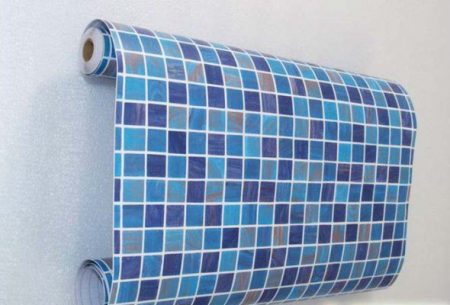
Number 4. Applications for self-adhesive wallpaper
And again about versatility. The material is so convenient and easy to use, and has such a wide selection of colors that enterprising designers have come up with the idea to use it in various whole, obvious and most unpredictable:
- wall decoration - The first and main scope of use. Self-adhesive wallpaper will fit as the main decoration material (remember that in the case of PVC it is necessary to ensure ventilation), as well as for emphasis. You can use wallpaper in any room, even in the kitchen and in the bathroom. For these rooms even release wallpapers simulating mosaic and tile. Someone uses self-adhesive that is easy to install, when they just want to change the room a little, but I don’t want to start repairs with dust and rubbish. Chalky wallpapers are perfect for children's rooms;

- furniture restoration. Old lockers, bedside tables and tables can be changed beyond recognition in a few hours. Guests will think you just brought them from the store. The reception is also suitable in cases where the furniture has not yet lost its appearance, but for some reason (tastes have changed, it no longer fits the interior) it needs to be slightly changed. With the help of self-adhesive wallpapers you can upgrade any furniture: from kitchen cabinets before walls in the living room and dresser in the bedroom. You can choose any color: stone finish, precious wood or just elegant patterns on a plain background. And if you are lucky to find a wallpaper with an imitation of stained glass, velvet, lace or with a mirror surface, you will be able to create a bright interior;

- door and window sill decor. These integral objects of each apartment lose their former gloss over time, but if at the same time they remain strong, then not everything is lost. Dozens of times repainted windowsill can be pasted over with wallpaper imitating marble or oak. FROM door leaf everything is more complicated: each decorative element, panel and glass insert make it more categorical to abandon the idea of pasting. Strictly speaking, a similar solution is suitable for a dull smooth web.
Very important choose the right shade and pattern self-adhesive wallpaper, especially when it comes to the PVC version. There are too many cheap materials on the market (both in value and in appearance) that will only spoil the interior. Actually, because of the simple, if not worse, looking film under a yellow tree, many were disappointed in self-adhesive wallpaper as a form of decoration and decor.
No. 5. Sticking self-adhesive wallpaper
Actually, the gluing process itself is very simple and should not cause any special difficulties. It is better to throw the main forces on the preparation of the surface and the material itself.
Surface preparation
The main thing is that the surface should be as even as possible. It is better to remove the old finish, if there are small irregularities, use puttyif everything is completely bad, then align the walls it's better stucco. After this, you should go through the primer, and when everything dries up, proceed to the next stage.
Some are in a hurry so much that they allow sticker of self-adhesive wallpaper on top of the old finish. “And what if the foundation is completely even? It’s saving time and effort! ”They will say and will be only partly right. Indeed, when the repair is urgent, self-adhesive can be glued on top of the wallpaper, but remember that adhesion will be many times worse than with a primed wall. Gluing the film onto the film is also undesirable. And in that, and in that case, the likelihood increases that the multilayer finish will begin to move away from the wall. If all this happens in the kitchen, then the risk increases even more, because the material here will be constantly exposed to moisture and fatty fumes.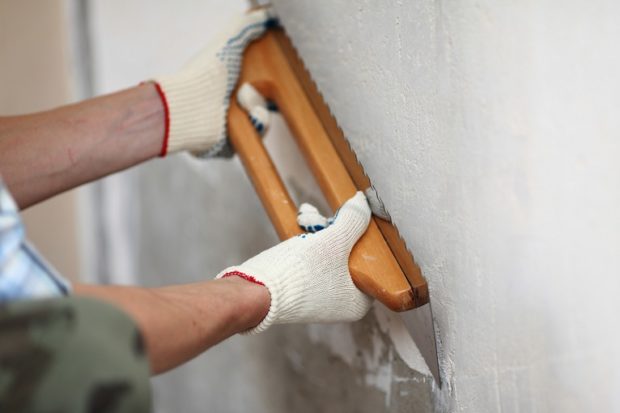
If you are going to wallpaper only part of the wall, then at this stage the surface does not interfere mark the boundaries of the required zoneto further simplify your task. Experts recommend maintaining parallelism of the vertical lines to the walls, and horizontal - to the floor and ceiling.
Mark surface it is possible in the case when all the walls will be fully papered. This will achieve the most aesthetic result. It is necessary to draw a vertical line from an angle at a distance equal to the width of the wallpaper, draw the width of the wallpaper from it and draw a vertical line again using a level or plumb line. As a result, you get a whole grid that will help you navigate in the process of gluing.
Prepare furniture even easier. It is enough to clean and degrease the surface. It is better not to use a fabric that leaves a lint.
The process of preparation can also include roll cutting. If the canvas is plain, then you just need to measure a segment of the required length and add a few centimeters to the allowance. If there is a picture on the wallpaper, then it must be properly joined. Sometimes for joining an ornament you have to sacrifice relatively large pieces of canvas. Cutting such wallpaper is best done, focusing on the front part. It is better to cut the blade with a construction knife and a ruler.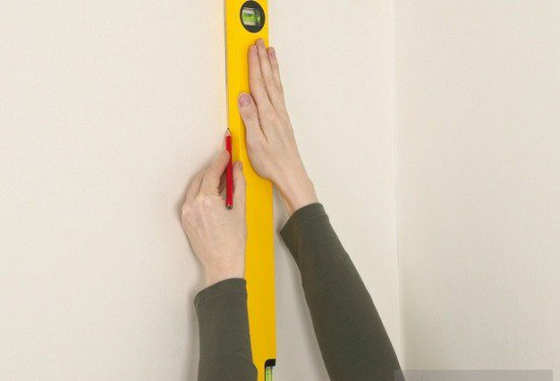
Wallpapering on the walls
The process of sticking self-adhesive wallpaper on the wall and furniture is extremely simple. It is necessary to take the prepared canvas and from the top edge begin to remove the protective paper.With the adhesive side, apply the canvas to the surface, constantly checking for evenness. The upper part of the wallpaper must be very well fixed using a sponge or squeegee. Now it remains to gradually remove the protective paper and gently press the wallpaper to the surface, constantly monitoring the level. Level the canvas with gentle movements using a plastic spatula, moving from top to bottom and from the center to the sides. If a bubble has formed that cannot be squeezed out from under the canvas, then it can be punctured with a needle, and then smooth out this place.
The glue dries in about 24 hours, so if any small defects are noticed, they can be fixed. Some manufacturers advise wetting the canvas with water for better fixation, but you will be warned about this in the instructions that accompany each roll of wallpaper.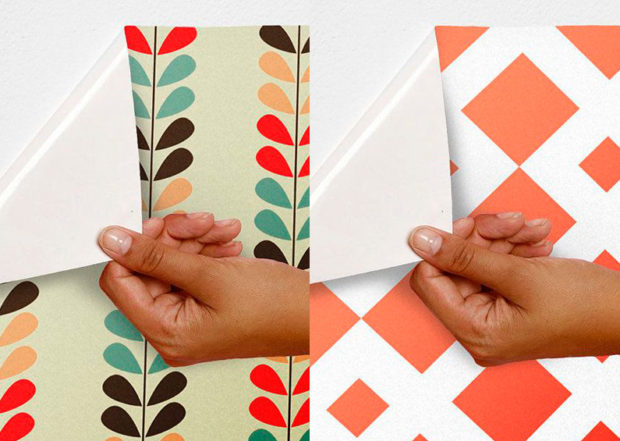
How to paste over furniture corners?
The process of mounting self-adhesive wallpaper on furniture fully coincides with the procedure for pasting walls described above. The only nuance is the angles that cause the most problems for inexperienced craftsmen. To make the angle neat and without wrinkles, some use heating with a hairdryer. It really becomes more elastic, but at the same time its useful performance may be lost, so it is better to act differently.
The film must be glued to one of the planes forming an angle, make an incision along the end line, bend part of the film and glue it to the surface. The second segment of the film is glued on top of the first. As a result, an inconspicuous seam is formed at the end, and there will be no wrinkles or other misunderstandings. The process is well shown in the video.
How to peel off self-adhesive wallpaper?
Sooner or later, you will have to remove the finish, but you won’t have to suffer for a long time. Self-adhesive wallpaper and here bypass the usual wallpaper - they are removed very easily. In some cases, it will be enough to pull the canvas with an effort, and it will move away from the surface. If the wallpaper didn’t give in, you will have to heat them up a bit with a building hair dryer or fan heater. After that, the film will easily come off, and the glue can be removed with solvent.
In conclusion, we note that self-adhesive wallpaper is an inexpensive, fast and practical way to transform your own home.

